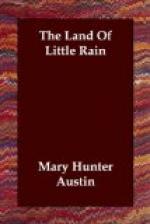Choose a hill country for storms. There all the business of the weather is carried on above your horizon and loses its terror in familiarity. When you come to think about it, the disastrous storms are on the levels, sea or sand or plains. There you get only a hint of what is about to happen, the fume of the gods rising from their meeting place under the rim of the world; and when it breaks upon you there is no stay nor shelter. The terrible mewings and mouthings of a Kansas wind have the added terror of viewlessness. You are lapped in them like uprooted grass; suspect them of a personal grudge. But the storms of hill countries have other business. They scoop watercourses, manure the pines, twist them to a finer fibre, fit the firs to be masts and spars, and, if you keep reasonably out of the track of their affairs, do you no harm.
They have habits to be learned, appointed paths, seasons, and warnings, and they leave you in no doubt about their performances. One who builds his house on a water scar or the rubble of a steep slope must take chances. So they did in Overtown who built in the wash of Argus water, and at Kearsarge at the foot of a steep, treeless swale. After twenty years Argus water rose in the wash against the frail houses, and the piled snows of Kearsarge slid down at a thunder peal over the cabins and the camp, but you could conceive that it was the fault of neither the water nor the snow.
The first effect of cloud study is a sense of presence and intention in storm processes.
Weather does not happen. It is the visible manifestation of the Spirit moving itself in the void. It gathers itself together under the heavens; rains, snows, yearns mightily in wind, smiles; and the Weather Bureau, situated advantageously for that very business, taps the record on his instruments and going out on the streets denies his God, not having gathered the sense of what he has seen. Hardly anybody takes account of the fact that John Muir, who knows more of mountain storms than any other, is a devout man.
Of the high Sierras choose the neighborhood of the splintered peaks about the Kern and King’s river divide for storm study, or the short, wide-mouthed canons opening eastward on high valleys. Days when the hollows are steeped in a warm, winey flood the clouds come walking on the floor of heaven, flat and pearly gray beneath, rounded and pearly white above. They gather flock-wise, moving on the level currents that roll about the peaks, lock hands and settle with the cooler air, drawing a veil about those places where they do their work. If their meeting or parting takes place at sunrise or sunset, as it often does, one gets the splendor of the apocalypse. There will be cloud pillars miles high, snow-capped, glorified, and preserving an orderly perspective before the unbarred door of the sun, or perhaps mere ghosts of clouds that dance to some pied piper of an unfelt wind. But be it day or night, once they have settled to their work, one sees from the valley only the blank wall of their tents stretched along the ranges. To get the real effect of a mountain storm you must be inside.




